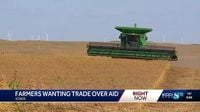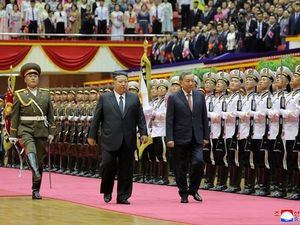U.S. soybean farmers are staring down one of their most challenging harvest seasons in recent memory, caught in the crosshairs of an escalating trade war between Washington and Beijing. As combines roll through Midwestern fields gathering what is expected to be a near-record crop—about 4.3 billion bushels, according to multiple reports—many growers are left wondering who will buy their beans now that China, historically their largest customer, has all but vanished from the market.
President Donald Trump, whose trade policies have reshaped the global agricultural landscape, announced on October 6, 2025, that his administration is preparing a significant aid package for U.S. soybean farmers. The move, reported by outlets such as CNBC and The Age, comes as Chinese tariffs and shifting trade alliances threaten to leave American silos overflowing and farm incomes under siege.
"The Soybean Farmers of our Country are being hurt because China is, for 'negotiating' reasons only, not buying," Trump wrote in a Truth Social post on October 1, 2025. "We've made so much money on Tariffs, that we are going to take a small portion of that money, and help our Farmers." The President’s statement reflects a mix of defiance and urgency. While he touts tariffs as a source of revenue, he also acknowledges the acute pain felt in rural America.
Treasury Secretary Scott Bessent—himself a soybean producer—echoed the administration’s commitment during an October 2 appearance on CNBC. Bessent said the public could expect news of “substantial support for our farmers, especially the soybean farmers” as soon as Tuesday, October 7. While the exact details of the aid package remain under wraps, sources familiar with the plan have suggested it could exceed $10 billion, providing a much-needed lifeline to producers grappling with the fallout of the trade standoff.
For American farmers, the timing couldn’t be more critical. The 2025 harvest season began in September, but China—once the buyer of about 60 percent of U.S. soybean exports—has not purchased a single American bean since May, according to The Age. Instead, Beijing has doubled down on its investments in Brazil and Argentina, securing agreements for 12 million tonnes of soybeans from those countries this season. Brazil alone has exported more than 66 million tonnes to China in 2025, now accounting for about 70 percent of China’s total soybean imports.
“Last year, as American farmers entered their harvesting season, China pre-purchased about 6.5 million tonnes of soybeans. This season? Not a bean,” The Age reported. The shift has left U.S. growers with a glut of unsold beans and a shrinking share of a once-dominant export market.
The roots of the crisis stretch back to Trump’s first term, when tariffs on Chinese goods prompted Beijing to retaliate with a 23 percent tariff on American soybeans—roughly $2 per bushel. That move instantly erased the U.S. cost advantage over Brazilian producers and made American beans less attractive to Chinese buyers. While China imported about $13 billion worth of U.S. soybeans in 2024, buying nearly a billion bushels in the first eight months, that figure has plummeted in 2025 to just over 200 million bushels.
Farmers are feeling the squeeze on multiple fronts. It’s not just the loss of their biggest customer; it’s also rising costs. Trump’s tariffs on Canadian fertilizer—Canada supplies up to 85 percent of U.S. fertilizer imports—as well as levies on metals and machinery, have driven up production expenses. John Deere, the iconic farm equipment manufacturer, has reported $600 million in tariff-related costs this year, leading to job losses and higher prices for already distressed farmers.
The trade war’s ripple effects extend beyond the U.S. and China. In September, the Trump administration announced a $20 billion swap line to support Argentina’s embattled peso and shore up the government of President Javier Milei, a political ally. Almost simultaneously, Argentina temporarily lifted a 25 percent export tax on soybeans and grains, generating $7 billion in hard currency in just two days—most of it from shipments to China. The move, though brief, added insult to injury for American farmers, who watched as their South American competitors capitalized on U.S. policy maneuvers that seemed to undercut their own market position.
Midwestern farmers, a group that has historically supported Trump, now find themselves conflicted. They value free trade and would prefer to compete on a level playing field rather than rely on government handouts. Yet the current landscape leaves them with few options. “America’s beleaguered farmers aren’t concerned about geopolitics. They are facing a glut of soybeans and other soft commodities, thanks to Trump’s protectionism,” The Age observed. For many, the promise of federal aid is a stopgap—not a solution.
Looking ahead, Trump has promised to raise the issue of China’s de facto ban on U.S. soybean imports in a meeting with Chinese President Xi Jinping set for November, coinciding with the expiration of the latest trade truce. Whether such talks will yield a breakthrough remains uncertain. Beijing, having invested billions to diversify its supply chains and reduce its reliance on American soybeans, holds considerable leverage. As The Age noted, “China is unlikely to be a large-scale buyer of U.S. beans even if the tariffs were removed.” Soybeans, it seems, have become a bargaining chip in a much larger geopolitical contest—one that includes not just agricultural trade, but also issues like advanced semiconductors and U.S. policy on Taiwan.
Meanwhile, the structural transformation of the global soybean market continues apace. With Brazil and Argentina ramping up production and export capacity, the U.S. faces the prospect of permanent changes in its share of the world market. The current aid package, while substantial, is widely seen as a temporary fix—"a Band-Aid for the stresses his country’s farmers are experiencing," as The Age put it. Unless the U.S. agricultural sector can adapt to this new reality, the glut of soybeans and the losses now being endured may become permanent features of the American farm economy.
Protectionism, as this saga illustrates, is a crude, two-edged sword. It may offer short-term relief, but it also brings lasting consequences for farmers, suppliers, and the broader export infrastructure. As combines continue to churn through Midwestern fields, the question on every farmer’s mind is simple: Who will buy America’s beans?
For now, U.S. soybean growers are left to wait—hoping for a trade breakthrough, bracing for more uncertainty, and relying on a government lifeline as the world’s agricultural power balance shifts beneath their feet.





